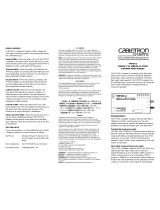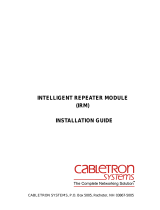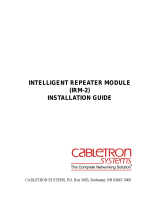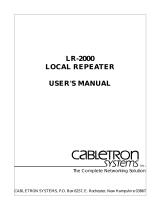Page is loading ...

REPEATER MEDIA INTERFACE MODULES
(TPRMIM/FORMIM/CXRMIM)
INSTALLATION GUIDE
CABLETRON SYSTEMS, P. O. Box 5005, Rochester, NH 03866-5005


Notice
Installation Guide
i
NOTICE
Cabletron Systems reserves the right to make changes in specifications and other information
contained in this document without prior notice. The reader should in all cases consult Cabletron
Systems to determine whether any such changes have been made.
The hardware, firmware, or software described in this manual is subject to change without notice.
IN NO EVENT SHALL CABLETRON SYSTEMS BE LIABLE FOR ANY INCIDENTAL,
INDIRECT, SPECIAL, OR CONSEQUENTIAL DAMAGES WHATSOEVER (INCLUDING BUT
NOT LIMITED TO LOST PROFITS) ARISING OUT OF OR RELATED TO THIS MANUAL OR
THE INFORMATION CONTAINED IN IT, EVEN IF CABLETRON SYSTEMS HAS BEEN
ADVISED OF, KNOWN, OR SHOULD HAVE KNOWN, THE POSSIBILITY OF SUCH
DAMAGES.
© Copyright 1994 by:
Cabletron Systems, Inc.
P.O. Box 5005, Rochester, NH 03866-5005
All Rights Reserved
Printed in the United States of America
Order number: 9030679-02 October 94
Remote LANVIEW
,
LANVIEW
,
Multi Media Access Center
and
SPECTRUM
are registered
trademarks of Cabletron Systems, Inc.
EMME
,
EMM-E6, RMIM
,
CXRMIM
,
TPRMIM
,
FORMIM
,
EPIM-A
,
EPIM-X
,
EPIM-F
,
EPIM-T
,
MMAC-3FNB
,
MMAC-5FNB
,
MMAC-8FNB
,
MMAC-M8FNB
,
IRM
,
IRM2
,
IRM3
,
and IRBM
are trademarks of Cabletron Systems, Inc.
Windows
is a registered trademark of Microsoft Corporation.
CompuServe
is a registered trademark of CompuServe, Inc.
UNIX
is a registered trademark of UNIX System Laboratories, Inc.
Printed On
Recycled Paper

ii
Repeater MIM
Notice
FCC NOTICE
This device complies with Part 15 of the FCC rules. Operation is subject to the following two
conditions: (1) this device may not cause harmful interference, and (2) this device must accept any
interference received, including interference that may cause undesired operation.
NOTE: This equipment has been tested and found to comply with the limits for a Class A digital
device, pursuant to Part 15 of the FCC rules. These limits are designed to provide reasonable protection
against harmful interference when the equipment is operated in a commercial environment. This
equipment uses, generates, and can radiate radio frequency energy and if not installed in accordance
with the operator’s manual, may cause harmful interference to radio communications. Operation of
this equipment in a residential area is likely to cause interference in which case the user will be
required to correct the interference at his own expense.
WARNING: Changes or modifications made to this device which are not expressly approved by the
party responsible for compliance could void the user’s authority to operate the equipment.
DOC NOTICE
This digital apparatus does not exceed the Class A limits for radio noise emissions from digital
apparatus set out in the Radio Interference Regulations of the Canadian Department of
Communications.
Le présent appareil numérique n’émet pas de bruits radioélectriques dépassant les limites applicables
aux appareils numériques de la class A prescrites dans le Règlement sur le brouillage radioélectrique
édicté par le ministère des Communications du Canada.
CABLETRON SYSTEMS, INC.
PROGRAM LICENSE AGREEMENT
IMPORTANT: Before utilizing this product, carefully read this License Agreement.
This document is an agreement between you, the end user, and Cabletron Systems, Inc. (“Cabletron”)
that sets forth your rights and obligations with respect to the Cabletron software program (the
“Program”) contained in this package. The Program may be contained in firmware, chips or other
media. BY UTILIZING THE ENCLOSED PRODUCT, YOU ARE AGREEING TO BECOME
BOUND BY THE TERMS OF THIS AGREEMENT, WHICH INCLUDES THE LICENSE AND
THE LIMITATION OF WARRANTY AND DISCLAIMER OF LIABILITY. IF YOU DO NOT
AGREE TO THE TERMS OF THIS AGREEMENT, PROMPTLY RETURN THE UNUSED
PRODUCT TO THE PLACE OF PURCHASE FOR A FULL REFUND.

Notice
Installation Guide
iii
CABLETRON SOFTWARE PROGRAM LICENSE
1. LICENSE.
You have the right to use only the one (1) copy of the Program provided in this
package subject to the terms and conditions of this License Agreement.
You may not copy, reproduce or transmit any part of the Program except as permitted by the
Copyright Act of the United States or as authorized in writing by Cabletron.
2. OTHER RESTRICTIONS. You may not reverse engineer, decompile, or disassemble the
Program.
3. APPLICABLE LAW. This License Agreement shall be interpreted and governed under the
laws and in the state and federal courts of New Hampshire. You accept the personal jurisdiction
and venue of the New Hampshire courts.
EXCLUSION OF WARRANTY
AND DISCLAIMER OF LIABILITY
1. EXCLUSION OF WARRANTY.
Except as may be specifically provided by Cabletron in
writing, Cabletron makes no warranty, expressed or implied, concerning the Program (including
Its documentation and media).
CABLETRON DISCLAIMS ALL WARRANTIES, OTHER THAN THOSE SUPPLIED TO
YOU BY CABLETRON IN WRITING, EITHER EXPRESS OR IMPLIED, INCLUDING BUT
NOT LIMITED TO IMPLIED WARRANTIES OF MERCHANTABLITY AND FITNESS
FOR A PARTICULAR PURPOSE, WITH RESPECT TO THE PROGRAM, THE
ACCOMPANYING WRITTEN MATERIALS, AND ANY ACCOMPANYING
HARDWARE.
2. NO LIABILITY FOR CONSEQUENTIAL DAMAGES. IN NO EVENT SHALL
CABLETRON OR ITS SUPPLIERS BE LIABLE FOR ANY DAMAGES WHATSOEVER
(INCLUDING, WITHOUT LIMITATION, DAMAGES FOR LOSS OF BUSINESS,
PROFITS, BUSINESS INTERRUPTION, LOSS OF BUSINESS INFORMATION, SPECIAL,
INCIDENTAL, CONSEQUENTIAL, OR RELIANCE DAMAGES, OR OTHER LOSS)
ARISING OUT OF THE USE OR INABILITY TO USE THIS CABLETRON PRODUCT,
EVEN IF CABLETRON HAS BEEN ADVISED OF THE POSSIBILITY OF SUCH
DAMAGES. BECAUSE SOME STATES DO NOT ALLOW THE EXCLUSION OR
LIMITATION OF LIABILITY FOR CONSEQUENTIAL OR INCIDENTAL DAMAGES, OR
ON THE DURATION OR LIMITATION OF IMPLIED WARRANTEES IN SOME
INSTANCES THE ABOVE LIMITATIONS AND EXCLUSIONS MAY NOT APPLY TO
YOU.

iv
Repeater MIM
Notice
UNITED STATES GOVERNMENT
RESTRICTED RIGHTS
The enclosed product (a) was developed solely at private expense; (b) contains “restricted computer
software” submitted with restricted rights in accordance with Section 52227-19 (a) through (d) of the
Commercial Computer Software - Restricted Rights Clause and its successors, and (c) in all respects
is proprietary data belonging to Cabletron and/or its suppliers.
For Department of Defense units, the product is licensed with “Restricted Rights” as defined in the
DoD Supplement to the Federal Acquisition Regulations, Section 52.227-7013 (c) (1) (ii) and its
successors, and use, duplication, disclosure by the Government is subject to restrictions as set forth in
subparagraph (c) (1) (ii) of the Rights in Technical Data and Computer Software clause at 252.227-
7013. Cabletron Systems, Inc., 35 Industrial Way, Rochester, New Hampshire 03867.
SAFETY
Designed in accordance with UL478, UL910, NEC 725-2(b), CSA, IEC, TUV,
VDE Class A. Meets FCC Part 15, Class A limits.
It is the responsibility of the person who sells the system to which
the TPRMIM, FORMIM, CXRMIM or EPIMs will be a part to
ensure that the total system meets allowed limits of conducted and
radiated emissions.
WARNING

Installation Guide
v
CONTENTS
CHAPTER 1 Introduction
1.1 Using this Manual........................................................................1-2
1.2 Getting Help.................................................................................1-2
1.3 RMIM Overview...........................................................................1-3
1.4 RMIM Features............................................................................1-4
1.5 The Multimedia Access Centers with FNB..................................1-6
1.6 The EMME...................................................................................1-6
1.7 The EMM-E6 ...............................................................................1-8
1.8 Related Manuals..........................................................................1-9
CHAPTER 2 Installation Requirements and Specifications
2.1 Network Cable Requirements......................................................2-1
2.1.1 10BASE-2 Thin-Net Network Requirements .................2-1
2.1.2 10BASE-T Twisted Pair Network Requirements ...........2-2
2.1.3 FOIRL/10BASE-FL Multimode Fiber Optic
Network Requirements for the FORMIM .......................2-4
2.1.4 FOIRL/10BASE-FL Single Mode Fiber Optic
Network Requirements for the FORMIM .......................2-5
2.1.5 Transceiver/AUI Requirements for the
TPRMIM-36 ...................................................................2-6
2.2 RMIM Network Port Specifications..............................................2-7
2.2.1 TPRMIM-20/22 RJ45 Connector Specifications ............2-7
2.2.2 TPRMIM-33/36 Champ Connector Specifications .........2-7
2.2.3 CXRMIM Coaxial Connector Specifications ..................2-9
2.2.4 FORMIM-22, ST Connector Specifications ...................2-9
2.3 Operating Specifications............................................................2-11
CHAPTER 3 Installing the RMIM
3.1 Unpacking the RMIM...................................................................3-1
3.2 Setting the RMIM Jumpers for the CXRMIM,
FORMIM and TPRMIM................................................................3-2
3.2.1 Setting the Ethernet Jumpers ........................................3-3
3.2.2 Setting the Unmanaged Module Group Jumper ............3-3
3.3 Installing the RMIM into the MMAC.............................................3-5
3.3.1 Installing an EPIM ..........................................................3-7
3.4 Connecting the RMIM/EPIM to the Network................................3-9
3.4.1 Attaching Thin-Net Segments to the CXRMIM ..............3-9
3.4.2 Connecting a Thin-Net Segment to an EPIM-C ...........3-10

vi
Repeater MIM
Contents
3.4.3 Attaching a Twisted Pair Segment to the
TPRMIM-20/22 .............................................................3-12
3.4.4 Attaching a Twisted Pair Segment to the
TPRMIM-33/36 .............................................................3-13
3.4.5 Connecting a Twisted Pair Segment to an
EPIM-T .........................................................................3-14
3.4.6 Connecting a Fiber Optic Link Segment to a
FORMIM, EPIM-F1, EPIM-F2, or EPIM-F3 ..................3-16
3.4.7 Connecting an AUI Cable to an EPIM-A
or EPIM-X .....................................................................3-19
CHAPTER 4 Testing the RMIMs
4.1 Pre-Installation Test.....................................................................4-1
4.2 Installation Check-Out..................................................................4-2
APPENDIX A Twisted Pair Wiring Tables
APPENDIX B EPIM Specifications
INDEX

Installation Guide
1-1
CHAPTER 1
INTRODUCTION
Welcome to the Cabletron Systems’
Repeater Media Interface Module
(RMIM™) Installation Guide
. This manual is a reference guide for Cabletron’s
family of RMIMs. These modules incorporate the Repeater Interface Controller
(RIC). The RIC is a multi-port repeater that enables the RMIMs to autonomously
repeat packets without channeling them to a repeater module. The following
RMIMs incorporate RIC technology:
•
TPRMIM-20™
&
TPRMIM-22™
–
The TPRMIM-20 provides nine
10BASE-T RJ45 Unshielded Twisted Pair (UTP) ports and one slot for a
Cabletron Systems Ethernet Port Interface Module (EPIM). The TPRMIM-
22 provides twenty-one 10BASE-T RJ45 UTP ports and one EPIM slot.
•
TPRMIM-33™
&
TPRMIM-36™
– The TPRMIM-33 has one
50-pin champ connector providing twelve 10BASE-T twisted pair ports and
one EPIM slot. The TPRMIM-36 has two 50-pin champ connectors
providing twenty-four 10BASE-T twisted pair ports, one AUI connector, and
one EPIM slot.
•
CXRMIM™
– The CXRMIM is equipped with twelve 10BASE-2 coaxial
connectors and one EPIM slot.
•
FORMIM-22™
–
The FORMIM-22 is equipped with twelve
FOIRL/10BASE-FL ports with ST type connectors.
This manual uses the term RMIM when describing features and
functions that are common to the TPRMIM-20, TPRMIM-22,
TPRMIM-33, TPRMIM-36, CXRMIM, and FORMIM-22.
NOTE

1-2
Repeater MIM
Chapter 1:
INTRODUCTION
1.1 USING THIS MANUAL
Read this manual to gain a full understanding of the features and capabilities of
the Cabletron Systems RMIMs. You should have a general working knowledge of
Ethernet or IEEE 802.3 type data communications networks and their physical
layer components before installing the RMIMs.
Chapter 1,
Introduction
, discusses the contents of this manual, briefly describes
capabilities and special features of the RMIMs, and concludes with a list of
related manuals.
Chapter 2,
Installation Requirements/Specifications
, describes installation
requirements, network guidelines, and operating specifications for the RMIMs
and EPIMs.
Chapter 3,
Installing the RMIM
, contains instructions for setting the RMIM
jumpers and installing the RMIMs into the MMAC/FNB. This chapter also
explains how to connect network segments to the RMIMs and EPIMs.
Chapter 4,
Testing the RMIMs
,
provides procedures for testing and
troubleshooting the installation of the RMIMs. It also explains how to use
Cabletron Systems’ LANVIEW diagnostic and monitoring system.
Appendix A,
Twisted Pair Wiring Tables
, contains wiring pinouts for
Punchdown Block applications.
Appendix B,
EPIM Specifications
, provides specifications and switch settings
for the Ethernet Port Interface Modules (EPIMs).
1.2 GETTING HELP
If you need additional support related to the Cabletron Systems RMIMs, or if you
have any questions, comments, or suggestions concerning this manual, contact
Cabletron Systems Technical Support:
By phone ..............................(603) 332-9400
Monday-Friday; 8am - 8pm EST
By CompuServe
®
.................GO CTRON from any ! prompt
By Internet mail ...................[email protected]

RMIM OVERVIEW
Installation Guide
1-3
1.3 RMIM OVERVIEW
Cabletron Systems Repeater Media Interface Modules provide connections to
10BASE-T, 10BASE-2, and FOIRL/10BASE-FL based Ethernet networks.
Figure 1-1 shows each module.
RMIMs repeat, retime, and regenerate each packet ensuring data integrity and
maximum data path distance. RMIMs also have a Fault Isolation feature that
automatically segments problem ports from the network. When the problem port
receives a good packet, the RMIM automatically reconnects the port to the
network.
Figure 1-1. Repeater Media Interface Modules
The RMIMs are designed, when managed by Cabletron’s Ethernet Management
Module for Ethernet (EMME or EMM-E6), to provide you with the capability to
add two additional Ethernet networks (B or C) to your existing Multi Media
Access Center
®
(MMAC) over the Flexible Network Bus (FNB). Sections 1.5,
1.6 and 1.7 of this chapter describe features of the MMAC, the EMME and the
EMM-E6.
CXRMIM
2
3
4
5
6
7
8
9
10
11
12
13
10BASE-2
ETHERNET
ETHERNET
B C
CLN
POK
RCV
POKRCV POKRCV
1
SN
FORMIM-22
CLN
RCV LNK
8
TX
RX
RCV LNK
2
RCV LNK
7
TX
RX
1
RCV LNK
9
TX
RX
RCV LNK
3
RCV LNK
10
TX
RX
RCV LNK
4
RCV LNK
11
TX
RX
RCV LNK
5
RCV LNK
12
TX
RX
RCV LNK
6
FOIRL/10BASE-FL
ETHERNET
SN
ETHERNET
B C
RCV LNK
RCV POK
CLN
SN
TPRMIM-36
10BASE-T
ETHERNET
14
RCV POK
1
1
2
3
4
5
6
7
8
9
10
11
12
13
13
2
26
15
ETHERNET
B C
CLN
14
15
16
17
18
19
20
21
22
23
24
25
26
R
C
V
L
N
K
R
C
V
L
N
K
SN
TPRMIM-33
10BASE-T
ETHERNET
RCV POK
1
1
2
3
4
5
6
7
8
9
10
11
12
13
13
2
ETHERNET
B C
CLN
R
C
V
L
N
K
TPRMIM-22
10BASE-T
ETHERNET
E
P
I
M
SN
2
X
3
X
4
X
LNK
RCV
CLN
11
12
13
14
15
16
17
18
19
20
21
22
1
2
3
4
5
ETHERNET
CLN
POK
6
7
8
9
10
B C
17
X
18
X
19
X
20
X
21
X
22
X
11
X
12
X
13
X
14
X
15
X
16
X
5
X
6
X
7
X
8
X
9
X
10
X
TPRMIM-20
10BASE-T
ETHERNET
B C
E
P
I
M
5
X
6
X
7
X
8
X
9
X
1
0
X
SN
2
X
3
X
4
X
LNK
RCV
1
2
3
4
5
ETHERNET
CLN
POK
6
7
8
9
10
LNK
RCV
LNK
RCV
LNK
RCV

1-4
Repeater MIM
Chapter 1:
INTRODUCTION
1.4 RMIM FEATURES
Repeater Functionality
The RMIM IEEE 802.3 compliant repeater provides the MMAC with the ability
to achieve maximum length data paths on each Ethernet network. To attain these
maximum length data paths, the RMIM retimes data packets and regenerates the
preamble of each data packet that enters the MMAC.
Additionally, the RMIM repeater functionality ensures that problem segments
connected to any port on the MMAC/FNB will not affect any other segments
connected to the MMAC/FNB. If 32 consecutive collisions are detected on any
segment, or if a collision detector is on for more than 110
µ
s, the RMIM will
automatically partition that segment from the MMAC/FNB. The segment will
automatically be reconnected to the MMAC/FNB when a packet is received from
the segment (or transmitted onto the segment, if using coaxial cable) without
causing a collision.
RIC technology provides an inter-RIC bus that allows for communication
between the RMIMs, allowing multiple RICs to be cascaded. The multiple RICs
communicating over the RIC bus act as a single logical repeater. This is a
significant advantage, since in the past, Ethernet networks were limited to four
serially linked repeaters. With cascading RIC repeaters, each of which support 13
cable segments, you can build a much larger network than you could with stand-
alone repeaters.
Unmanaged Grouped Module (Subnet) Capability
You can set Jumpers on the MMAC-installed RMIM to create an “unmanaged
module group” of boards using the B or C channel. The RMIM and all boards to
its left in the MMAC chassis no longer communicate across the FNB backplane
to the EMME, EMM-E6 or any modules to the right of the unmanaged module
group. This provides two additional “unmanaged” Ethernet networks. The
networks cannot be seen or managed from the EMME or EMM-E6 installed in
the MMAC. Section 3.2 describes how to set the RMIM jumpers.
Stand-alone Capability
You can also use the MMAC-installed RMIM as an “unmanaged” stand-alone
repeater.

RMIM FEATURES
Installation Guide
1-5
Remote Network Management Capabilities
You can manage the RMIMs remotely by any SNMP network management
system. Cabletron Systems offers the following remote management packages:
• Cabletron Systems SPECTRUM
®
• Cabletron Systems Remote LANVIEW
®
/Windows™
• SPECTRUM Portable Management Applications
Ethernet Port Interface Modules
Cabletron Systems’ Ethernet Port Interface Modules (EPIMs) provide additional
connection to the Ethernet network. Table 1-1 describes each EPIM.
LANVIEW LEDs
The RMIMs incorporate LANVIEW, Cabletron Systems’ built-in diagnostic and
status monitoring LED system. LANVIEW LEDs help you rapidly diagnose
device, port, and link problems. You can also view Ethernet status LEDs to
determine if the RMIM is running on Ethernet B, Ethernet C, or stand-alone
mode. Chapter 4 describes each LED.
Table 1-1. EPIMs
EPIM MEDIA TYPE CONNECTOR
EPIM-A AUI DB15 (Female)
EPIM-C 10BASE-2 Thin Coaxial BNC
EPIM-T 10BASE-T Unshielded Twisted Pair RJ45
EPIM-X Standard Transceiver DB15 (Male)
EPIM-F1 Multimode Fiber SMA
EPIM-F2 Multimode Fiber ST
EPIM-F3 Single Mode Fiber ST

1-6
Repeater MIM
Chapter 1:
INTRODUCTION
1.5 THE MULTI MEDIA ACCESS CENTERS WITH FNB
Cabletron Systems Multi Media Access Center with Flexible Network Bus
(MMAC/FNB) provides three separately repeated Ethernet segments: Ethernets
A, B, and C. The Cabletron Systems non-repeating Media Interface Modules
(MIMs) operate on Ethernet A, while the RMIMs are designed to operate on
Ethernet segments B and C. See Figure 1-2.
Figure 1-2. MMAC with FNB
The modular design of the MMAC allows the RMIMs to co-exist with other
MIMs to provide a variety of different media connections at one point. This
means that the RMIM can be used by itself or in conjunction with any
combination of other MIMs accommodating Twisted Pair, Fiber Optic Cable,
Thick or Thin Ethernet Coaxial Cabling, or AUI Cabling. Figure 1-3 shows a
sample configuration.
1.6 THE EMME
The Ethernet Management Module for Ethernet (EMME) provides management,
bridging, and routing (optional feature) for four Ethernet channels; channels A,
B, and C on the MMAC backplane and channel D from the EMME AUI port. The
four EMME channels access the same shared memory so that packets received on
one channel can be forwarded to any or all of the other channels.
Power & Management Bus
Flexible Network Bus
Ethernet A Bus
Ethernet B Bus
Ethernet C Bus

THE EMME
Installation Guide
1-7
The EMME uses Ethernet Channel A on the MMAC backplane to transmit and
receive data from Cabletron Systems non-repeater MIMs (i.e., TPMIMs,
FOMIMs, THN-MIMs). The EMME provides repeater functionality for these
MIMs.
Figure 1-3. Ethernets A, B, and C
Ethernet channels B and C transmit and receive packets over the Repeater
Interface Controller (RIC) management bus on the FNB to Cabletron Systems
RMIMs (TPRMIM, FORMIM, and CXRMIM). RMIMs can repeat packets
autonomously without channeling them through the EMME.
Two redundant AUI ports on the EMME’s front panel let you access Ethernet
channel D. The AUI ports allow you to connect the module to a variety of
Ethernet transmission media including twisted pair, fiber optic, or thick or thin
Ethernet coaxial cable.
TPRMIM-36
EMME
TPRMIM-33
CXRMIMFORMIM-22FORMIM-22TPMIM-24
TPMIM-24
Channel A
Channel B Channel C
Channel D

1-8
Repeater MIM
Chapter 1:
INTRODUCTION
When using the Cabletron Systems EMME along with the RMIMs, you have the
network management capabilities that enable you to control the RMIM and its
attached segments. For example, you can gather information on the number of
good packets and collisions that pass through each port on the RMIM.
1.7 THE EMM-E6
The EMM-E6 (Ethernet Management Module) is a six port bridge/router module
with four Ethernet bridge/router ports and two user selectable bridge/router ports.
The EMM-E6 provides management, bridging, and routing for three Ethernet
channels; channels A, B, and C on the MMAC backplane and a fourth external
Ethernet segment (channel D) via an Ethernet Port Interface module (EPIM).
Two Bridge/Router Interface Module (BRIM) ports can be configured to provide
additional bridging or feeder node routing on Ethernet, Token Ring, FDDI, ATM
or Wide Area Networks (WAN).
The EMM-E6 uses Ethernet Channel A on the MMAC backplane to transmit and
receive data from Cabletron Systems non-repeater MIMs (i.e., TPMIMs,
FOMIMs, THN-MIMs). The EMM-E6 provides repeater functionality for these
MIMs.
Ethernet channels B and C transmit and receive packets over the Repeater
Interface Controller (RIC) management bus on the FNB to Cabletron Systems
RMIMs (TPRMIM, FORMIM, and CXRMIM). RMIMs can repeat packets
autonomously without channeling them through the EMM-E6.
The EMM-E6 provides two slots for optional EPIMs on the front panel. The
EPIMs provide an Ethernet D channel for various transmission media
connections (twisted pair, fiber optic, and thick or thin Ethernet coaxial cable).
Using two EPIMs provides redundancy for the external network connection but
note that only one EPIM operates at any given time.
The two Bridge Router Interface Modules (BRIMs) perform the same bridging
functions as EPIMs, however, unlike EPIMs, BRIMs bridge packets from one
transmission type to another (e.g., Ethernet to FDDI, ATM to Wide Area, etc.).

RELATED MANUALS
Installation Guide
1-9
1.8 RELATED MANUALS
The manuals listed below should be used to supplement the procedures and other
technical data provided in this manual. The procedures in them will be
referenced, where appropriate, but will not be repeated.
Cabletron Systems’
Multi Media Access Center (MMAC-M8FNB, MMAC-
5FNB, MMAC-M3FNB) Overview and Set Up Guide
Cabletron Systems’
Ethernet Management Module (EMME) User’s Guide
Cabletron Systems’
EMM-E6 Installation Guide

1-10
Repeater MIM
Chapter 1:
INTRODUCTION

Installation Guide
2-1
CHAPTER 2
INSTALLATION
REQUIREMENTS/SPECIFICATIONS
This Chapter describes cable requirements, network guidelines, and operating
specifications for the RMIMs. Be sure that you read this chapter before you
install the RMIMs. Your network must meet the requirements and conditions
specified in this chapter to obtain satisfactory performance from this equipment.
Failure to follow these guidelines could result in poor network performance.
2.1 NETWORK CABLE REQUIREMENTS
Take care in planning and preparing the cabling and connections for your
network. The quality of the connections and the length of cables are critical
factors in determining the reliability of your network. The following sections
describe cable requirements for each media type.
2.1.1 10BASE-2 Thin-Net Network Requirements
When connecting a 10BASE-2 thin-net coaxial segment to the CXRMIM or
EPIM-C, your network must meet the following requirements:
Cable Type
50 ohm RG-58A/U type coaxial cable must be used when making up a thin-net
cable segment.
Length
The thin-net segment must be no longer than 185 meters.
Terminators
A 50 ohm terminator must be connected to the far end of each thin-net segment.

2-2 Repeater MIM
Chapter 2: INSTALLATION REQUIREMENTS/SPECIFICATIONS
Connectors
A maximum of 29 tee-connectors may be used throughout the length of cable
segment for host connections. If an excessive number of barrel connectors are
used within the cable segment, such as finished wall plates with BNC
feed-throughs, then a reduced number of host connections may be required. For
special network design, contact Cabletron Systems Technical Support.
Grounding
For safety, ground only one end of a thin-net segment. Do NOT connect EPIM or
CXRMIM BNC ports to earth ground.
2.1.2 10BASE-T Twisted Pair Network Requirements
When connecting a 10BASE-T Twisted Pair Segment to a TPRMIM-20/22/33/36
or EPIM-T, your network must meet the following requirements:
Length
The IEEE 802.3 10BASE-T standard requires that 10BASE-T devices transmit
over a 100 meter (328 foot) link using 22-24 AWG unshielded twisted pair wire.
However, cable quality largely determines maximum link length. If you use high
quality, low attenuation cable, you can achieve link lengths of up to 200 meters.
Cable delay limits maximum link length to 200 meters, regardless of the cable
type.
Insertion Loss
The maximum insertion loss allowed for a 10BASE-T link is 11.5 dB at all
frequencies between 5.0 and 10 MHz. This includes the attenuation of the cables,
connectors, patch panels, and reflection losses due to impedance mismatches in
the link segment.
Impedance
Cabletron Systems 10BASE-T Twisted Pair products will work on twisted pair
cable with 75 to 165 ohms impedance. Unshielded twisted pair cables typically
have an impedance of between 85 to 110 ohms.
Connecting a thin-net segment to earth ground at more than one
point could produce dangerous ground currents. The BNC ports of
the CXRMIM are connected to earth ground, eliminating the need
of grounding the segments connected to the BNC ports. The EPIM-
C provides a switch to select either internal or external termination.
WARNING
/










